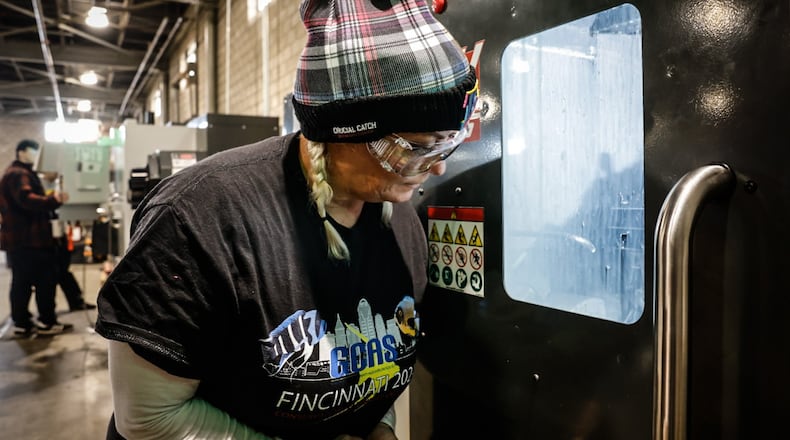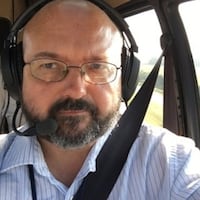In an effort led by the Dayton Foundation and former Air Force Research Laboratory Executive Director Joe Sciabica, a group calling itself the “Dayton Workforce Coalition” has set several ambitious goals, chief among them: Get about 23,000 working-age people off the sidelines and back into the regional labor force by the year 2030, not annually, but across that period.
Members also hope to help attract 2,000 to 4,000 or more new residents to the region by 2030. And they hope to guide efforts to retain 1,000 to 4,000 residents in the same period — many of them college graduates not originally from the region.
In all, the foundation is investing $625,000 into the effort.
The goals are lofty, acknowledged Mike Parks, president of the Dayton Foundation.
“We’ve seen nothing like this in our lifetimes,” Parks said.
Credit: Jim Noelker
Credit: Jim Noelker
‘Everybody wins’
“Workforce is important for a few different reasons,” Ohio Lt. Gov. Jon Husted said. “But when you think about it, when you get it right, everybody wins.”
When workers are hired, personal living standards rise. Business productivity improves. Communities grow in healthy ways. Success begets success as businesses take note of where other businesses succeed — or fail.
The coalition’s goal is to organize an array of local efforts to address facets of the problem. The coalition wants to become a resource for the community as a whole, looking at “gaps” in efforts, uniting partners, answering questions from one direction, suggesting action and recommendations in another, Parks said.
Every day, coalition members will think about this problem, members said in interviews with the Dayton Daily News.
“They absolutely will become a resource,” Parks said. “They become a group that looks for change, that looks for strategies, that brings partners together who maybe haven’t been brought together before.”
The 103-year-old foundation is no stranger to that kind of role.
The workforce coalition is modeled in part after the foundation’s nonprofit “Learn to Earn Dayton” effort, created about a dozen years ago to harness resources to help address the educational needs of Dayton-area children.
Notably, Learn to Earn has become a magnet for funding and grants from like-minded organizations. For example, in August, it was announced that Learn to Earn Dayton would receive $3.6 million over four years from StriveTogether, a national organization with a similar mission to help kids succeed.
“We learned from Learn to Earn that we can do that as a community,” Parks said.
Other foundation initiatives have resulted in the Miami Valley Works program, the Crayons to Classrooms teachers store and more. One key moment in the foundation’s history: When construction of the downtown Dayton Benjamin and Marian Schuster Performing Arts Center was considered stalled in the late 1990s, the foundation supported the issuance of bonds and contributed $1 million in grants, boosting the project.
National problem, local focus
It’s difficult to have a conversation with a C-level business executive in which workforce does not come up.
“We interact with hundreds of local businesses and organizations on a regular basis, and I can say in our conversations with them, the challenge around workforce is a topic that affects just about everyone in one way or another,” said Tim Mislansky, CEO of Wright-Patt Credit Union. “Sometimes the challenges are around finding and attracting the right employees. Other times, it is about retaining quality people. Sometimes it’s about both.”
Sciabica has united a team that includes four organizations, beyond the Dayton Foundation: The Dayton Development Coalition, the Dayton Business Committee, the Greater Dayton Area Hospital Association and the the Dayton Area Chamber of Commerce.
Workforce is not just a Dayton issue. As of late November, there were about 8 million job openings in the United States, but only 6.8 million unemployed workers, according to the U.S. Chamber of Commerce, relying on federal data.
During the COVID-19 pandemic, more than 30 million U.S. workers were unemployed at one point, the chamber says. The situation has steadily improved since then, with employers adding more than 3 million jobs in 2023.
Credit: Jim Noelker
Credit: Jim Noelker
But too many former workers have remained on the sidelines since the pandemic. The Brookings Institution think tank says workforce participation has stagnated at about 1 percentage point below its pre-pandemic level.
Doug Barry, founder and president of Dayton-area employee placement firm BarryStaff Inc., sees some recent signs of a keener desire from some workers to rejoin the labor force, a problem he believes has resisted easy solutions since even before the COVID-19 pandemic.
Since mid-September this year, the problem has gotten better, said Barry, who is also a trustee for Miami Twp. government. Perhaps local layoffs have sharpened appetites for jobs. But he believes the local labor participation rate is ticking up.
Generally, when people retire, they don’t quit working completely, Barry said, adding that he is starting to see older workers return to the labor force.
“Now is it where it needs to be?” Barry said. “No, we’re still far from that.”
The competition for workers is keener than ever, and expectations cut in both directions.
“What I see is that employees are also looking for greater flexibility than ever before, and we’re seeing a strong emphasis on work-life integration,” Wright Patt Credit Union’s Mislansky said. “We’re also seeing that more people care about the true purpose work of their organizations and how it aligns with their personal beliefs. I’d argue these are positive changes, but they are changes that business are having to balance as well.”
20,000-plus new jobs each year
A growing need for qualified workers is good news, but it creates a challenge — and an opportunity.
The Dayton Workforce Coalition is working with local data, courtesy of research from consulting firm McKinsey and Co. The coalition estimates there will be 26,000 net new jobs annually through the year 2030 in a 14-county region around Dayton, and a need to fill some 28,000 recurring openings each year due to natural attrition.
Retirements are part of the issue. Natural aging and retirements creates some 25,000 jobs a year, coalition members said.
“It’s a demographic problem,” Husted said. “Demographic problems are very difficult to overcome.”
“I know when I was on the base, we watched this every year. If everybody who is eligible to retire can retire and does retire, we’re in dire straits,” recalled Sciabica, who retired from the Air Force in 2015 to become president of what was then Universal Technology Corp.
“It wasn’t lost on me when I came to this community in 2005 that there were 20,000 vacancies a year,” he added. (Sciabica became director of AFRL’s Sensors Directorate at Wright-Patterson in 2005.)
Beyond that, it’s expected there will be some 20,000-plus new jobs across the region each year at least for the next six or seven years.
“If you put those together, there’s an opportunity box here of about 40-plus-thousand jobs to fill,” Parks said. “That’s never happened in our lifetimes. How are we going to work on that? "
‘We have to have partners’
The problem, in one sense, is a good one to have. JobsOhio and the Dayton Development Coalition have been “uber-successful” in attracting new employers while helping employers already here to expand, Parks said.
Michelle Bryant, a partner in the Columbus office of McKinsey & Co., with experience in engineering and law, said McKinsey research shows there is “more opportunity for Dayton relative to peer regions across Ohio.”
The Dayton region in the aftermath of the pandemic did not see a labor force participation rebound as strong as that seen in other regions, said Sciabica.
Coalition members estimate the overall need is to have somewhere between 6,000 and 23,000 people a year returning to the labor force.
“We just can’t do everything ourselves,” Sciabica said. “We have to have partners.”
Bryant said the region’s working-age population has actually grown in the past few years after many years of decline.
“I think it’s a super interesting data point,” she said. “Most people are surprised when they hear that.”
Bryant’s analysis has sought to forecast the net new additional workforce needs of the 14-county region over the next handful of years.
“Those fundamentally are STEM-heavy jobs,” Sciabica said. “Some are four-year degree jobs, a lot of them are skilled trades jobs that are technical in nature.”
Big hiring events — such as AFRL’s in October at the Fairborn Holiday Inn and an Air Force Life Cycle Management Center event in 2023 — are additional clues, if any are needed, to the local need for qualified employees in STEM-reliant fields.
‘Work it out’
Some employers are making big moves. A joint venture Honda-LG Energy electric vehicle battery plant is being built, for example, outside Jeffersonville. Sierra Nevada is here and is expanding, building a third and fourth hangar near Dayton International Airport. Joby Aviation has said its Dayton operation won’t operate until next year. DMAX has built a new truck engine plant in Brookville.
The Intel construction project east of Columbus is happening but has slowed.
Wright-Patt Credit Union has been making inroads into the Columbus-area market, building new member centers there.
“WPCU has more than 90 years of reputation built in the Dayton area, so we have a pretty steady flow of applicants,” Mislansky told this newspaper. “In our Columbus market, where we do not have the history, we do see more challenges around recruiting.”
Employers are willing to hire people at an earlier age, Husted said. College degrees in some fields are regarded as less crucial than other attributes, such as demonstrated skills, he said.
Hearing of the new Dayton coalition, Husted said he thinks a team approach is worth pursuing. There is value in having local leaders “getting in the same room talking about how they’re going to solve each other’s problems,” he said.
It’s good to bring people together, but you must have “deliverers of the services” in the room, too — meaning educational institutions and employers, he added.
Said Husted: “Put them in the room and have them work it out.”
About the Author




